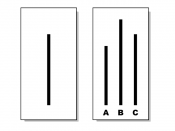There have always been two sides to every issue. The right side, usually told by the first person to speak, and the wrong side, inferred irrationally by the opposed. In the article"Ethical Relativism: Who's to Judge What's Right and Wrong?" Louis Pojman addresses the belief that society dictates what is right and wrong. He provides three different theses on how morality is viewed and accepted. He categorizes these as "An Analysis of Relativism" (14). When trying to understand the ribbon of morality, you must begin with the threads of diversity woven together using tolerance with understanding, resulting in a fragile trimming that illustrates your present personal view of what is right and wrong.
The first thesis, the Diversity Thesis, declares that right and wrong are at a society or cultural level (15). Right and wrong are based on what society asks of people and believes is acceptable.
The majority of society we currently live in believes that the killing of babies is morally wrong and a heinous crime, while also believing that abortion is acceptable. Although these two beliefs should reside within the same fiber, society chooses to segregate or color them separately. This allows them the juxtaposition of opposing beliefs on the same subject, while providing the ability for acceptance of differing moral views. With the differing of societies, so right and wrong also differ. What one culture or society believes is right and good, may be morally wrong and shunned by another. "It behooves us not to judge others but be tolerant of diversity" (14). Society and culture are built upon diversity. Pojman's diversity thesis acknowledges that moral rules differ from society to society. For instance, a society that believes that bathing should be done only in hot soapy water to be cleansed is no...


